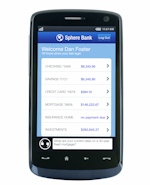Nuance: technology that speaks your language - Nuance
The retail banking industry has long been at the forefront of technology-driven innovation, particularly regarding customer service. With financial service organisations looking to restore public confidence in the wake of the global crisis, implementing the right high-end functionalities has never been so important in rebuilding their image.
Essentially, this means providing touchpoints that are more uniform and transparent. Consequently, players can differentiate themselves through providing call centre operations predicated on personalisation, security and creativity, particularly when meeting the needs of today's mobile consumers.
Empowerment for banking consumers
Headquartered in Burlington, Massachusetts, US, Nuance Communications is a leading provider of voice and language solutions for businesses and consumers around the world. It continues to work closely with 14 of the top 15 global banks to help them to meet the mobile needs of their customers, and achieve innovative and cost-efficient customer service.
"We have seen a fair amount of diversity across the banking sector recently," says Seb Reeve, director of product management and marketing for the group's EMEA activities. "Organisations are starting to invest heavily in the user experience through non-phone channels, which has seen the emergence of the mobile space."
In concert with changing habits, for many of today's banking customers, the mobile platform is denoted by an app on a smartphone, allowing for tasks such as checking accounts or making payments. This has seen Nuance adapt its web-to-mobile product offering accordingly, as Robert Gary, vice-president and general manager of mobile enterprise applications, explains.
"Consumers are more empowered than they were, say, five years ago," he explains. "People want to do more with their mobiles. In terms of bridging the gap between web-based and mobile functionalities, banks are doing a pretty good job compared with other verticals. The right investments are being made."
Exacting needs for mobile traffic
Delivering the best technology is no small undertaking, with Gary admitting that merging functionality and information is "quite a design challenge, for even the most competent app builder". In today's fast-paced consumer environment, users of such technology are also more exacting in their demands.
"We are talking about an attention span ranging from around 30 seconds to two minutes," says Gary. In terms of the challenges and opportunities surrounding mobile, people want something that is really robust and easy to use. But if it isn't fast, the immediate perception is that it is not a good solution."
A key element to appreciate is security, according to Reeve.
"What we are seeing in the financial space is the creation of more barriers in the face of that kind of ease of access," he says. "It's not only about usability and building functionality into the channel, but also about getting the access in the first place. We need to get this right; otherwise it will push a lot of people back to phones to conduct transactions."
Another potential quandary facing financial institutions seeking to gain ground in the mobile space is simply keeping up with the trend, which continues to proliferate at a heady rate.
"Mobile traffic is already eclipsing the web, even with limited functionality," says Gary. "Subsequently, a lot of our customers that I meet with are both excited and a little worried by this - they are wary of driving down call-centre volumes, which were previously automated, while still in the process of investing in the mobile channel.
"However, the general belief is that when this technology is implemented correctly, it can lend a superior advantage to your customer service model. Consumers can satisfy a number of queries at their fingertips within 30 seconds to a minute, rather than having to call and wait in a queue to be patched through to an agent."
Virtual automation
In August this year, Nuance unveiled Nina, a virtual assistant for mobile customer service apps, enabling customers to manage their financial affairs in a simpler, faster and more efficient manner. Able to incorporate speech recognition and voice biometrics into a single integrated solution, it is already being cited as a watershed development for the automated service industry.
According to Gary, the product came about on the back of Nuance's considerable market experience and presence in the mobile field, where it serves OEM providers.
"Nuance has a rich heritage in providing automated contact centre solutions to the financial industry," he explains. "In the development of Nina, we took a two-pronged approach: one was to try and figure out how to add speech and natural language, while the other was to focus on the business angle and to create an app that was genuinely useful."
Marketed as a software development kit (SDK), Nina is also the first solution that can support the integration of speech-based virtual assistant capabilities into existing iOS and Android mobile apps. This, in turn, enhances flexibility and the overall self-service experience for the customer.
"We deliver Nina to the customer as an SDK," says Gary. "The main benefit of this is that it doesn't require a fundamental technology shift. It has been created with the idea of improving their solutions, as opposed to replacing them.
"The SDK service also includes the Nina virtual assistant persona, which allows developers to use the available source code to quickly create a customised persona. This also means users can start working with it immediately rather than starting from a blank page."
Natural language understanding
Authentication and security is of paramount concern when it comes to mobile banking. Through features such as natural language understanding - currently comprising Australian, UK and US English, with support for additional languages in the pipeline - banking customers can access their account through a simple voice command, eschewing tedious password requests synonymous with online platforms.
"If you subscribe to the theory that people are trying to get things done faster in a highly mobile environment, the elimination of the erroneous typing of passwords is useful," says Gary. "This has been solved through an easy voice command, which allows people to get into the app more quickly with greater security."
Room for improvement
Despite a favourable market reaction to Nina - USAA, the US military home, life and auto insurance provider has already signed up for it - Nuance will not rest on its laurels. With ROI firmly in mind, the group is already planning it next steps.
"We are certainly excited about what we have achieved, bearing in mind that it is a first-generation project, but there is so much more that we can do," says Gary. "In terms of Nina's ROI, it's really about creating a more engaging, useful, effective experience. The direct benefit for the bank is that with easy use comes greater levels of engagement and customer satisfaction.
"Nina supports the ability to increase automation rates without sacrificing the experience, and that objective has always been a difficult balance with other technologies such as IVR. It's a delicate area, but it's something you can only really get with the likes of Nina."



